-
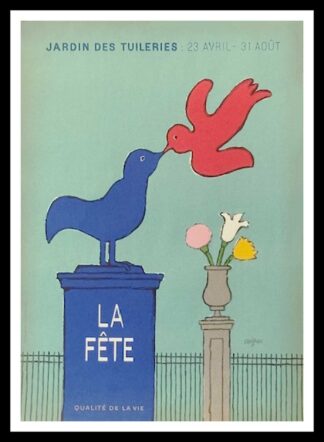
Raymond SAVIGNAC original vintage poster, Jardin des Tuileries, la fête qualité de la vie, 1976
220,00€ -
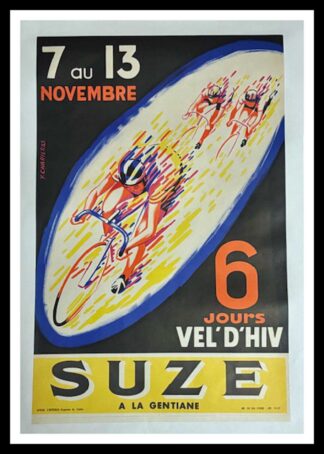
Y. CHARIERAS original vintage poster race cycle, 6 jours du Vel d’Hiv, Suze, 1950
200,00€ -
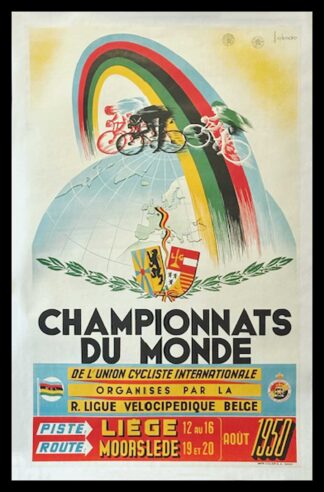
MOORSLEDE original vintage cycle poster, Championnat du Monde de cycles Liège, Belgique, 1950
600,00€ -

KAMA original vintage ski poster, MEGEVE, Téléférique du Mont d’Arbois circa 1940
2 800,00€ -
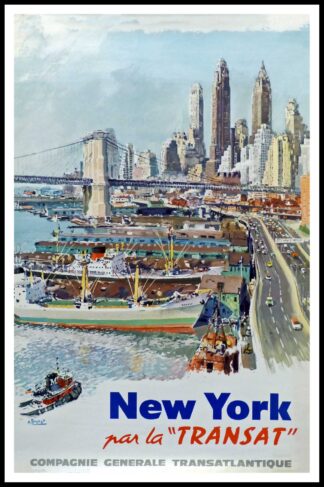
Albert BRENET original vintage travel poster, NEW YORK par la Transat, Cie Générale Transatlantique, circa 1950
1 200,00€ -
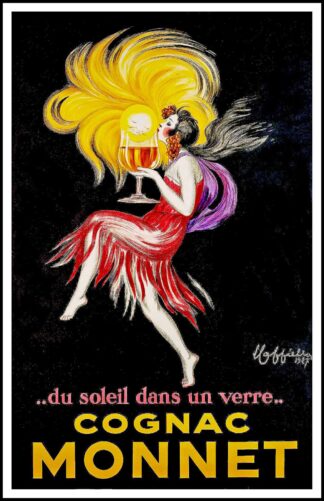
CAPPIELLO : original vintage advertising poster – Cognac Monnet, 1927
6 500,00€ -
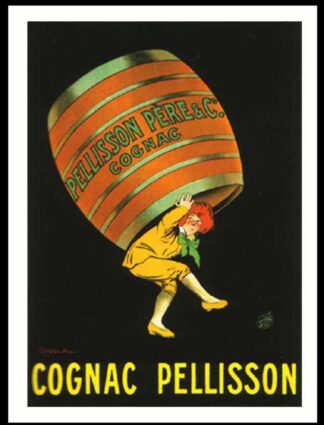
CAPPIELLO : original vintage advertising poster – Cognac Pellisson, 1907, big size
2 500,00€ -
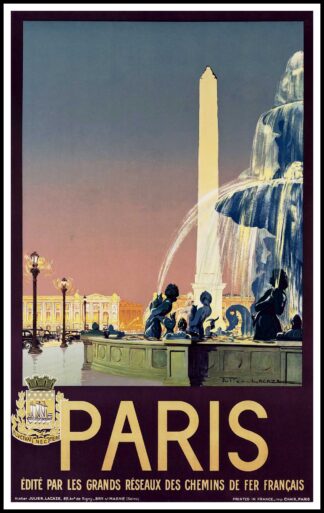
Julien LACAZE : original vintage travel poster – Paris Place de la Concorde, French National Railways 1938
1 500,00€ -
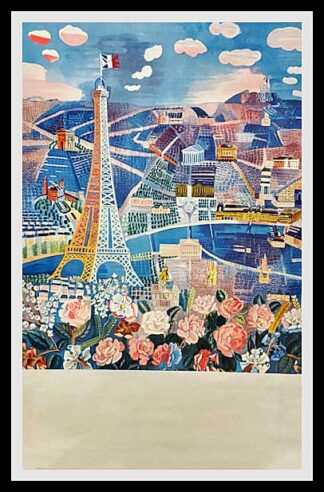
Raoul DUFY original vintage travel poster – Le printemps à Paris, le paravent, 1950 before letter
1 200,00€ -
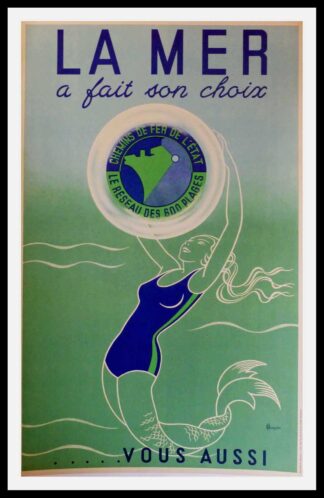
ROQUIN original vintage travel poster – La mer a fait son choix … vous aussi, Normandy, Brittany, Chemin de Fer l’Etat, 1937
950,00€ -
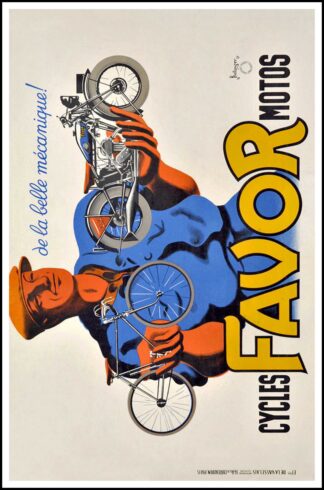
BELLENGER : original vintage advertising poster – Cycles motos FAVOR de la belle mécanique, 1937
1 500,00€ -
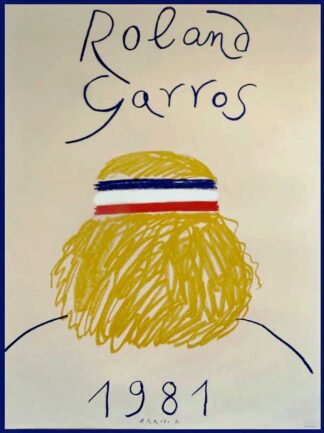
Edouardo ARROYO : original vintage tennis poster – Roland GARROS, Björn Borg, 1981
1 500,00€
POSTER PAUL VINTAGE POSTERS PARIS FRANCE
The Paul Maurel gallery (www.poster-paul.com) specializes in the sale of vintage posters. The gallery was established in 1987 when it acquired the Isabelle Maurel Gallery, which originated in Paris in 1974. We posses a large inventory of advertising vintage posters.
Our original authentic antique posters date from the beginning of the twentieth century with the Art Nouveau period and the 1930’s Art Déco. In a more modern vain, we also carry posters including nouveaux graphics beginning from just after the end of World War II in the 1950’s style and continuing through to the present.
The Paul Maurel gallery is open Saturday, Sunday, and Monday from 11 AM to 5 PM. To view our collection and contact us at your convenience, visit our web site: www.poster-paul.com
Art Nouveau
The art nouveau period marks the début of the poster. This new style of communication is credited to Jules Chéret as having created the first original posters. His posters were seen throughout Paris and across France. He was equally at home with designing and creating advertising posters for brand name companies including Saxoléïne, Théâtrophone, Le Palais de Glace, as he was in promoting cabarets, entertainers, and artists. Chéret designed posters for the Moulin Rouge, Arlette Dorgere, Casino de Paris, and Théâtre de l’Opéra. Jules Chéret generated a great demand for original art posters which paved the way for the arrival of new artistes including Jules Alexandre Grün for Bal Tabarin; Alfred Choubrac for his posters on operettas; Misti and his magnificent Fêtes de Neuilly; Georges Meunier; and the exceptional artist Jean Poelogue who worked under the pseudonym Pal, was known for the posters he created for the Folies Bergères.
Unquestionably, the master of original art posters was Toulouse Lautrec. He began painting posters after seeing the Moulin Rouge by Jules Chéret. He went on to create a large number of original posters. Toulouse Lautrec confirmed his talents with his posters Divan Japonais, Jane Avril, le Chap Book, la Passagère, and Aristide Bruand.
Original posters offered a form of expression and creativity that reached out to artists of all levels and styles. The young Swiss artist, Steinlen impressed Paris with a considerably more realistic style than his predecessors. This can be seen in his masterpieces Mothu & Doria, le Lait de la Vingeanne, le clinique Chéreau, and le Bodinière.
Art Nouveau coveted the beginning of the twentieth century. The style was apparent in paintings, sculptures, furniture, and, of course, original posters by artists such as Alphonse Mucha, Eugène Grasset, and Paul Berthon.
Alphons Mucha, the young Czech artist, created exceptionally beautiful posters of the actress Sarah Bernhardt for her theater roles including Lorenzaccio, la Dame aux Camélias and la Samaritaine. He showed off his talents in advertising for les Bières de la Meuse, le Salon des Cent, le Papier à Cigarettes Job (Job Cigarette papers), as well as lithographs and decorative panels les têtes Byzantines, l’Aurore, le Crépuscule, les Quatre Saisons (the Four Seasons), and les Bijoux et les Etoiles.
The Maître of Art Nouveau, Eugène Grasset, displayed his talents through his posters Encre Marquet, Place Clichy and the decorative panels Abricotine and Mélancolie. Paul Berthon gave his interpretation of Art Nouveau through numerous compositions such as Sarah Bernhardt, The Hermitage and Leçon de Violon (the Violin Lesson). Artists from other countries also participated in inspiring this innovative movement including Privat-Livemont nicknamed the Mucha Belge. He created several posters including Cabourg and Le Cercle Artistique (the Artistic Circle). The use of original posters as a form of communication is established with the development of 20th century commercial products which make use of original posters as a way to advertise their goods.
During this time, with the bicycle well underway as a fast-growing business, the talent of poster artists is solicited by various brands, Chéret for l’Etendard Français and Cleveland; Pal for Clément bicycles; H. Gray makes magic for Phébus and Liberator; Mucha for Perfecta; Misti for Humbert; and Frédéric Wintrop Ramsdell for Crescent cycles.
The beginning of the 20th century witnessed the birth of the automobile and with it numerous poster artists are called upon to create appropriate advertising. Some of the most prominent are: Misti for Panhard, Pal for Phébus, Abel Faivre for l’Automobile Club de France, Vincent Lorant-Heilbronn for Hurtu, Charles Lucas for Georges Richard, Georges Redon for Panhard and Levasseur Weiluc (Lucien Henri Weil) for Bayard.
Artist Leonetto Cappiello, referred to as the father of modern advertising, is credited for the transition between Art Nouveau and Art Déco. He astounded the beginning of the turn of the century with his particular style by bringing his Italian influence and creativity to France. He gained notoriety with his advertising posters for Froufrou, Champagne Delbeck, l’Absinthe Ducros, Chocolat Klaus, and Automobiles Brasier.
The rapid development and expansion of tourism also used posters as a medium for advertising. Railway lines lured customers to a variety of destinations drawing upon poster artists for advertisements. Jules Chéret transported the imaginations of travelers to Nice; Jean Hugo d’Alési illuminated France, as did Dellepianne and Tanconville. The innovation of the pullman (sleeping cars) were responsible for original posters by H. Gray and Dellepianne.
The infatuation for poster art spawned art critics and publishers who wrote revues, informative works, references, and documentation on the subject. The principal reviews and magazines were la Plume, la Critique, l’Estampe, and l’Affiche (1897-1899) and l’Image (1896-1897). Similar works could be found in Belgium with the Affiche Artistique, and in England which produced The Studio and The Poster as reference works. Books based on original posters were written by Ernest Maindron with les Affiches Illustrées in 1896, Emile Bauwens in1897 with les Affiches Etrangères, and Demeure de Beaumont with l’Affiche Belge.
By the end of the 19th century, original posters were a popular collector’s item. Through merchants, posters could be purchased on subscription. The magazine, la Plume, commercialized posters making it possible to purchase Jane Avril by Henri Toulouse Lautrec for 5 francs.
Moreover, plates were made to produce reduced format editions of posters represented world-wide. This technique was put into use in Maîtres de l’Affiche printed by Chaix. The most famous creators were represented by Louis Rhead for le Journal the Sun; Beggarstaff for Harper’s Magazine; Lucien Métivet for the Concert des Ambassadeurs, Eugénie Buffet; Albert Guillaume for the Théâtre Ambiguë, gigolette 1894; Georges Meunier for the advertising campaign of Chemins de Fer de l’Ouest excursion en Normandie et Bretagne 1896 (The west railway excursion in Normandy and Britanny); Pierre Bonnard for the celebrated Revue Blanche 1894; Pal for the théâtre de l’Olympia Grand Ballet Brighton 189; Lucien Lefèvre for l’Electricine 1895; Hugo d’Alési for l’Exposition du Centenaire de la Lithographie 1895; Giovanni Mataloni for l’Incandescence par le gaz système Auer 1895; Roedel for the Moulin Rouge de la Galette 1896; Gabriel Ibels for Mevisto; Gerbault for le Chocolat Carpentier 1895; Privat Livemont for the Casino de Cabourg 1896; Crespin for Paul Hankar architecte; Boutet de Monvel for l’Opérette la petite Poucette 1891; Maurice Denis for the Dépêche de Toulouse 1892; Manuel Robbe for la coupe à pétrole l’éclatante 1895; Georges de Feure for the journal des ventes 1897; Anquetin for Marguerite Dufay; Hohenstein for le Centenaire de la découverte de la pile volcanique 1898 Milan; Georges Fay for les sardines Amieux 1899; René Péan for the stores A la Place de Clichy 1898; Boano for;e Théâtre Royal de Turin 1898, Paul Berthon for la Revue l’Hermitage 1897; Rochegrosse for l’Opéra Comique Louise 1900; Henri Cassiers for the Red Star Line 1899; Ferdinand Gottlob for the Salon des Cent 1898. Jules Chéret, represented by fifty-nine original posters, Henri de Toulouse Lautrec with the Divan Japonais, la Revue Blanche, Moulin Rouge la Goulue, and la Chaîne Simpson. As well as Alphonse Mucha with Gismonda, the 20th exposition du Salon des Cent, Lorenzaccio, la Dame aux Camélias, la Samaritaine, Bières de la Meuse, and the Papier à cigarettes Job.
L’ART DECO
From 1910 on, Art Déco begins to filter into the mentality of the artists coming on the scene as new life styles are created. From 1920 through 1940 Art Déco spread throughout the arts. Concerning original posters, this was translated through the work of the incontestable master painter Adolphe Mouron Cassandre (1901-1968). His radical style a can be seen through le Normandie 1935, and the modernizing transportation system can be seen in Etoile du Nord, Nord Express selling speed with LMS Best Way. Cassandre, considered the master or “Maître” of original posters of the century due to his understanding of the economic upheaval of the time.
His refined style was taken up by Loupot with posters for Voisin and Peugeot cars, and by Carlu with Aquarium de Monaco and the dentifrices Gelés (Gelés toothpaste). These works revealed the modernity of the twentieth century.
Furthermore, modernism is found seeping into other areas of life and art most notably the music-hall as seen though Paul Colin and his magnificent original posters for the Revue Nègre, Joséphine Baker, and Isodora Ducan.
In all commercial domains, posters serve as advertising as a means to sell. The automobile Peugeot with Accélération is accredited to Paul Colin, Leonetto Cappiello for 15 HP, and Bellenger for Berliet.
Advertising for liquor and other drinks is created by masters including Jean d’Ylen for Rhum Charleston, Paul Mohr for Cherry Rocher, and Mercurey Kina, as well as Cappiello for Bitter Campari and Florio Cinzano. Spring is at the fore with Cognac Sorin as is St Hall with Cognac Sauvion.
Special occasions are also celebrated by original posters. Jean Dupas illustrates for le Salon des Artistes décorateurs, Georges Barbier for le Bal des petits lits blancs, Georges Lepape for le Bal de la Couture as well as Jean Gabriel Domergue.
Tourism is also advertised in original posters. All French regions flaunt their patrimony but, it is though advertising for the sea and the mountains that the most famous original posters are created. La Côte d’Azur is addressed by Roger Broders for Juan Les Pins, Monaco, and Grasse. Sem designs posters for Cannes, Fix-Masseau for the Côte d’Azur, Santoni, Jean Don for Cannes, Falcucci for Juan les Pins, Cappiello for Nice and Fabuis Lorenzi and Louis Icart for Monte Carlo.
Posters advertising mountain-related vacations were made by Roger Broders for Chamonix, Roger Soubie for la Mer de Glace, Géo Dorival for le Mont Blanc, R. Michaud for Megève, Paul Ordner for Combloux, Gorde for l’Alpes de Suez, Benigni for Brides les Bains. Various regions of France were illustrated by Géo Dorival, Commarmond, and Julien Lacaze.
Original posters depicted the sea with vacations that included trans-Atlantic travel and travel world-wide. Poster artist Sandy Hook illustrates for les Antilles, Albert Brenet for the Compagnie Transatlantique, Albert Sébille for travel to New York, Max Ponty for Maroc.
THE 1950’s
This period was greatly influenced by the reconstruction of France after the war. The return of economic possibilities propelled people to buy, consume, and develop. The masters of the original posters during this time were Savignac and Villemot. Original posters remained the main vector of communication. Savignac worked for Perrier, Cinzano liquors, Bic pens, Dunlop tires, and for Monsavon soaps.
Poster artist Villemot imposed his personal style on the field. His illustrations were original and a continuation from work dating before World War II. Villemot began his career in original posters by working for public services. He worked for the treasury department, the French coast and beaches, government loans, and the fight against cancer. Ironically, but merely a sign of the times, he also worked for the cigarette companies Gitanes, Tigra and Gauloises. Villemot made his mark through personal contacts and designed posters for Bally, Perrier, and Orangina.
Hervé Morvan is another poster artist who achieved fame during this post-war period. He illustrated for Panzani, Lustucru, Banania, Pam Pam, Waterman, and Week-end cigarettes. Transportation services used original posters to sell trips and vacations. Air France offered trips to the far east with work by artists Guerra for Mexico, S. Proust for Canada, José Doré, and Vasarely for South America.
私たちのギャラリーは古いポスターの販売を専門としています。ポールモーレルギャラリー
(www.poster-paul.com)は1987年から存在し、1974年にパリで始まったイザベルモーレルギャラリ
ーの継承であり、古い広告ポスターの在庫が豊富です。
私たちの選択は、20世紀の初めから古いアールヌーボー様式のポスターで確立され、その後1930
年代にも古いアールデコのポスターで確立されています。さらに、戦後50年代のスタイルから今日に至る新しいグラフィックで現代の世界を探求し続けています。
私たちのギャラリーは、古いリトグラフを展示していますミロ、パブロ・ピカソ、ソニア・ドローネー、ラウル・デュフィ、アンリ・マティス、ジャン・ガブリエル・ドメルグ、チリダス、ケリー、アレクサンダー・カレル
ギャラリーは土曜日から月曜日まで午前11時から午後5時まで営業していますが、特にウェブサイトでは24時間オープンしており、インターネット上でオリジナルのポスターを公開しています:www.poster-paul.com
我们的画廊专门从事旧海报的销售。保罗·莫雷尔(Paul Maurel)画廊(www.poster-paul.com)自1987年成立以来,是伊莎贝尔·莫雷尔(Isabelle Maurel)画廊的继承人,该画廊于1974年在巴黎成立,并有大量的旧广告海报。
我们的选择是从20世纪初开始使用旧的新艺术风格海报建立的,然后在1930年代使用旧的艺术装饰风格的海报建立。此外,我们将继续以崭新的图形探索现代世界,这些图形从战后时代开始以50年代的风格发展到今天。
我们的画廊展示了旧石版画米罗,巴勃罗·毕加索,索尼亚·德劳内,拉乌尔·杜菲,亨利·马蒂斯,让·加布里埃尔·多梅格,奇利达斯,凯利,亚历山大·卡勒
该画廊的开放时间为星期六至星期一上午11点至下午5点,但尤其是每天24小时在其网站上开放,并在互联网上展示原始海报:www.poster-paul.com
